August is the end of the beekeeping year. If the beekeeper has been lucky, it culminates in the sticky process of extracting golden honey. For the last few days I have been eating honey spooned over raspberries, strawberries and peaches. Soon it will be apple season and I’ll drizzle it over warm stewed apples. I must also remember to eat it spread over toast, all warm and gooey.
This year has been good to us. On Saturday Jonesie, Emma and I were all busy clearing our bees down from the supers, ready to take the honey off. One of Jonesie’s colonies must have had an inkling what was going on, as they chased us around the apiary. Below you can see Jonesie hiding from them. A visitor made the mistake of entering without any suit on and quickly ran away yelping!
The hives have black tape around them to stop any wasps or bees getting in. We put a clearer board underneath the supers so that the bees could go down but not back up, and then collected the frames on Sunday. We have taken two supers and will soon take another, so I am hopeful that we will actually have surplus honey to sell this year, as well as giving it to friends and family and leaving enough for the bees.
Now that the honey has been spirited away ready for extraction, we can begin varroa treatment using Apiguard. While inspecting I noticed a few bees with deformed wings and also black shiny bodies caused by Chronic bee paralysis virus (CBPV), which is associated with varroa. It is so sad to see the bees with tattered, useless wings, so it will feel good to nuke some mites.
By the way the National Honey Show website has a good recorded lecture, ‘Ghosts in the Hive – Varroa’s life cycle inside a Honey Bee Colony‘, in which scientist Ricarda Kather talks about her research on the mites. One of the topics she talks about is how varroa mimics the smell of their host bee whilst riding on its back, so that the mites pass undetected by bees. Within the space of three hours a mite can adjust its odour to every single bee it clings to, from nurse bees to foragers (bees smell different as they get older). They can do this even when dead, so the process must happen automatically without any effort being required by the mite.
Above you can see our bees doing a yoga class, displaying excellent balance and posture as they do the downward dog position. They are also revealing their Nasonov glands at the tip of their abdomen, releasing a pheromone to attract fellow colony members back home. They tend to do this when hive parts are moved – here the crown board had been propped up next to the hive.
Here are a few photos of the summer.
Dandelions by water.
Daisies planted in a wildflower style meadow, Walpole Park in Ealing
Evening clouds over Elthorne Park
And finally, this year Britain and other European countries are commemorating the hundred year anniversary of the start of the First World War, known at the time as the Great War. During my lunch break last week I walked down to the Tower of London Bloodswept Lands and Seas of Red art installation. The Tower of London website says:
“Created by ceramic artist Paul Cummins, with setting by stage designer Tom Piper, 888,246 ceramic poppies will progressively fill the Tower’s famous moat over the summer. Each poppy represents a British military fatality during the war.”
It is quite shocking to look down on the moat and realise that each of these thousands of poppies represents a person, someone who died in a place of misery due to the greed of others. The display has beauty in the form of the flowers but also a certain horror, as its flowing lines resemble a splattered river of blood. So much wasted life because of the selfish ambitions of a few. What have people learnt from this? A quick read of the news each morning suggests nothing much at all.

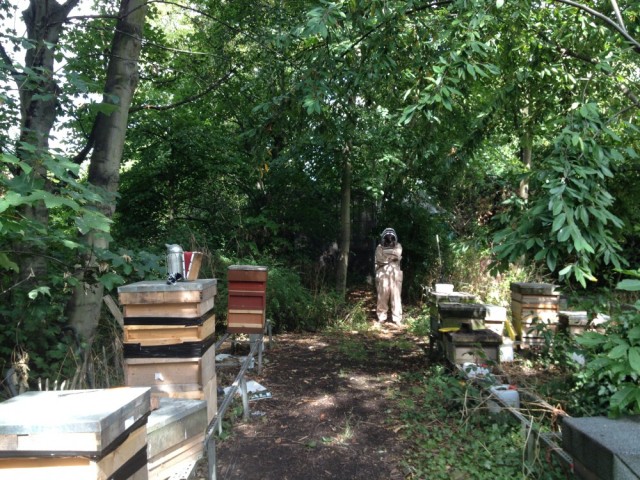
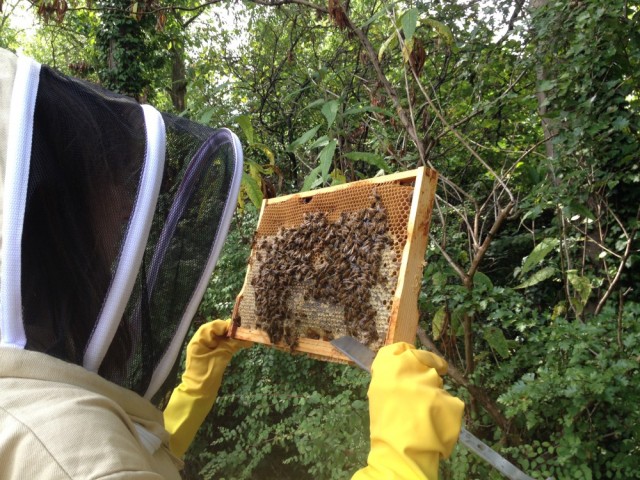
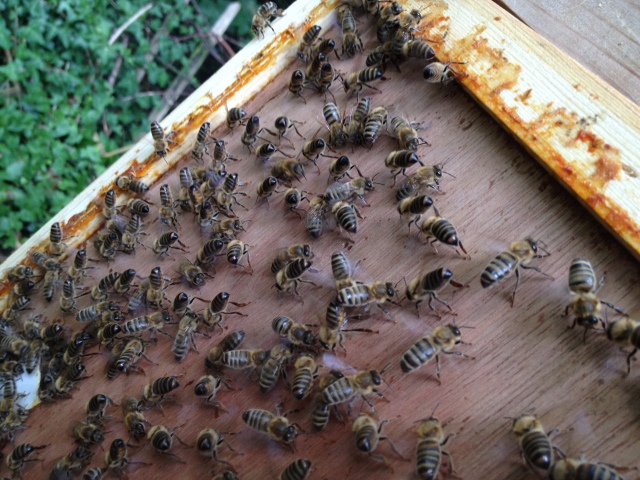

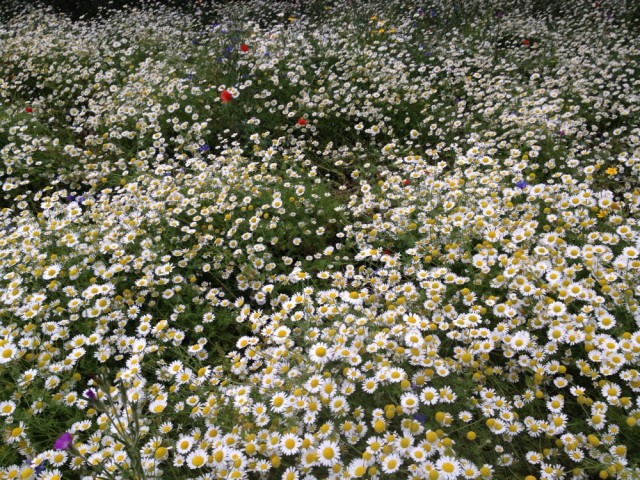
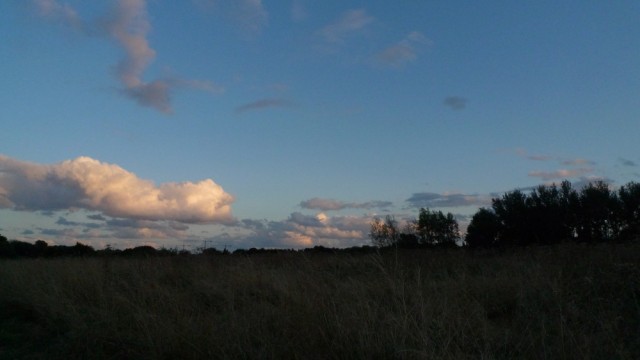

How exciting that your lovely bees may have made enough honey to share so abundantly! It must be a great relief for you to be able to treat them for the ailments you’ve been noticing. Thank you for the lovely photos – I particularly enjoy the bees doing yoga. 🙂 I’ve read about the art installation at the Tower of London and wished I could see it. Your description is more vivid than any photos I’ve seen yet. Seeing it through your eyes makes me think it may be just as well I won’t be there in person, as I suspect I might be reduced to a blubbering wreck by such deep sadness.
LikeLike
Thanks Jennifer. I am hoping I’ll be able to catch the bees doing pilates and spinning classes later in the season.
LikeLiked by 1 person
Now that I would really like to see! 😉
LikeLike
Yum and gorgeous photos too! Those poppies, so beautiful and very moving.
I was wondering what the dark bee was in my latest post? If you have the time to pop over? It is in the mass of bees. Maybe just differently colored?
LikeLike
Thank you Cindy. If you mean the bee in the centre of your first photo, I can’t see enough of it to be sure. It could be a honeybee but then again its thorax looks fluffier than the others, so perhaps it is a species of carpenter bee trying to get in on the sugary action.
LikeLike
I’ll be interested to hear how many kilos you get per hive. This looks like it’s been a much better year weatherwise in England so hopefully the crop will be a good one.
LikeLike
Trust me, our crops are nothing like yours! Most of our honey will be coming from Myrtle’s hive, from which we have got around 60 pounds (26 kilograms). Queen Stella’s hive has produced around 60 pounds too, but I will only take one 30 pound super from that. The most I’ve heard of anyone getting this year is seven 30 pound supers from one colony.
LikeLike
Actually, last year we only averaged 10 kilos per hive. That is partly because any hive that was strong enough was split (sometimes 2 splits came from each hive) in Spring and it was a very dry year so not a lot of nectar around. Some of the hives did really well but some were awful so the average was disappointing (yet still more than 200kgs of honey so can I really complain?).
When we lived in suburbia and had 2 strong hives we got 80 kilos per hive. Can the split and weather explain all that difference? Maybe 30 hives on this property is also a problem – too many mouths to feed?
LikeLike
You may be right about 30 being too many. Sometimes having fewer but stronger hives can result in more honey.
LikeLike
Hi Emily what a brilliant blog post I love following your blog it’s so informative 🙂 can I ask how the black tape stops bees? I’m a total newbie and I’ve never heard of that before 🙂 I hope you have delicious honey, I’ve been enjoying some local honey on toast for my breakfast. Infact I’m having that for my breckie tomorrow morning 🙂
LikeLike
Thanks Lottie 🙂 We only put the tape round while the clearer boards are on. Normally the bees would defend the honey, but the idea of the clearer boards is to leave the super free of bees for easy removal. So the tape stops other bees or wasps finding a hole and getting in to rob the honey.
I had a terrible experience once of putting bee escapes on and coming back 24 hours later to find every single comb in the super empty, completely robbed out. There had been a hole just big enough for insects to get in whilst it was undefended. Never again!!
LikeLike
Okay, I have to admit I’m envious of all your honey. My bees swarmed so many times, I’m not going to get any this year. I’ve got two hives just barely hanging on and four hives that I can’t open. How smart is that? Not very smart. I’ve read that bees get very defensive at this time of year, so I guess a full bee suit is in order.
I have to agree with your summation…”What have we learned?” “Not much.”
LikeLike
No honey has happened to me and Emma two years running, so I’m very grateful to have honey this year! They do get more defensive in August, preserving their beautiful honey for the upcoming winter must be on their minds.
LikeLike
Pleased to hear you are able to take some honey this year, that must feel good.
Thank you for sharing the photo of the poppies, I had not heard about this installation. As you say,the blood effect is very troubling.
LikeLike
Thanks. I’ll try to go back and take more photos of the poppies later in the summer, when even more have been added.
LikeLike
I wish you a good honey harvest. Do you make mead from your honey?
LikeLike
Thank you. I have been on a one-day course to learn mead making, but it does require some special equipment and patience in waiting several months. I came to the conclusion I’d rather buy it!
LikeLike
Those bees definitely know what I was up to. Good blog again!
LikeLike
Cheers. They’re going to be even less happy now you’ve taken their honey away!
LikeLike
I have to admit that if I were a beekeeper in your area, I’d be one pleasantly plump beek! 🙂 The idea of honey drizzled on fruits and berries sounds perfect for our rainy day today. The only thing I’d add is a touch of cheddar to dip in the honey, one of my most favorite flavor combos ever!
Our harvest is, hopefully, either this Saturday or next. We sometimes get a smaller, second round in September. Of our three healthy hives, I will probably only harvest off the first. Maybe the second. I like to leave a lot of honey to avoid sugar feeding, and I’m not convinced they have enough.
And thanks for the pictures of the poppies. I saw that in the news and was touched by the memorial. I don’t know if I’ve told you this, but my father is a retired Air Force pilot, and the war memorials around the world have always been especially meaningful to me. The one around the Tower of London seems particularly stirring and potent. What a beautiful and yet somber and tragic reminder of the sacrifice of so many. Thanks for sharing!
LikeLike
Mmm honey and cheese goes together really well. I once went to a Italian restaurant where they served honey over various soft cheeses. Best of luck with your harvest.
Glad you liked the poppies. It must take great bravery to be an Air Force pilot, up there exposed in the sky battling against an enemy shooting at you. If you haven’t read it, I recommend Roald Dahl’s Going Solo, which has some really moving/tense passages about his time as a RAF pilot in WW2.
LikeLike
Hello,
To lower varroa numbers you might want to try a brood break in some of your hives.Several members in our club in Richmond ,BC, report good results.They normally do it in July 1-10. It involves removing all frames of uncapped brood and the queen to another nuc box or new hive. The original hive will not have eggs for 25-35 days,depending on how fast the new virgin queen mates. This break prevents the varroa having capped larvae to breed in. I have also heard of beekeepers putting the queen in a cage in her own hive for 34 days.
LikeLike
I do agree with doing a brood break, but we prefer to do ours in the spring with a shook-swarm and keep the original queen. It sounds like a bit of a palaver to split the hive in half or cage the queen when the weather is suitable for Apgiuard. I can see the advantages but still.
LikeLike
Love the daisies! I agree with you 100% that we don’t learn much at all from history and we keep repeating the same mistake.
LikeLike
It is sad. The people at the top forget, or they don’t care, they just see the money and power at the end as they send others off to war.
LikeLike
Glad this has been a good season for the bees and you have at last got a harvest you are pleased with. Amelia
LikeLike
Thanks Amelia – I feel a bit less of a rubbish beekeeper this year! Now the focus will be on getting the colonies strong and healthy for winter.
LikeLike
I’m happy that the bee-keeper gods, or more likely goddesses, have been good to you this year – you have definitely earned every millilitre of your liquid gold. I’m sure the bees don’t mind sharing with you as you look after them so well!
LikeLike
Ah yes, they would be golden goddesses. We have not taken honey from all the hives and will give some back to Myrtle’s if we feel they need it.
LikeLike
I just love that meadow with the daisies and little spots of color here and there. I can image bees love it too. So shiny bodied bees is sick bees. I have been seeing them here and thought they were small Carpenter bees. Now I will have to catch one to see closer. I love honey and have some everyday. I would be in heaven having my own fresh, personal supply.
LikeLike
There is a photo & some info on the black shiny bees here: https://secure.fera.defra.gov.uk/beebase/index.cfm?pageid=275. Sometimes carpenter bees are shiny so hopefully you were seeing them. The bees infected by CBPV cannot fly, so are usually only found by beekeepers around their hive.
LikeLike
That Jonesie is no fool. Then again neither are the bees. I also had not known about that poppy installation. Quite a moving image…
LikeLike
The only downside of the poppy installation is it’s apparently confusing the local bees!
LikeLike
Nice post. Good luck with the honey harvest.
LikeLike